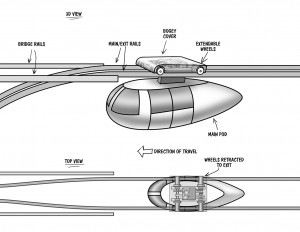PRT: Personal Rail Transit
GlidewayPRT stands for a system of personal, small, lightweight public vehicles which are available to the public at many convenient locations and are on-call. It is all electric, fully automated, and runs on elevated tracks over many major through fares.
This elevated system is designed for performing above traffic using BiModal Glideway’s special switching systems which take advantage of the only space left in congested urban environments, i.e., the space above the streets and sidewalks/greenery. In order to relieve surface congestion we need to utilize some of this space without polluting the streets or air. Our concept takes advantage of open space without polluting and minimizes the physical appearance while improving all traffic flow.
Most stations will be elevated approximately 6 feet above the main track which requires 15 feet clearance above the street. We anticipate that many department stores, business buildings, and major industrial buildings will be willing to have a PRT station connected to the side of their building at the second floor. All PRT stations will require an elevator from ground level to the station level. The frequency of use and size of each station will be determined by anticipated use, available temporary PRT vehicle storage at the station, etc.
We believe all PRT traffic should be one-way on each side of a major through-way, maximizing esthetics, while reducing noise, and switching problems. However, two-way may be more economical. We have minimized the amount of horizontal space required for either one-way or two way-tracks and for switching and stations.
The guideways that the PRT vehicles travel on will deliver electric power to the vehicles and collect the users’ costs and send the data to the PRT managing agency which will send data to all of users local power companies for collection.
This concept has PRT vehicle storage/parking areas in many multilevel high rise facilities for compact overnight storage, maintenance and redistribution of vehicles. During working hours they are distributed to areas with anticipated heavy needs. Other than maintenance crews, the anticipated needs will be established by special computer analysts. Each day/night the vehicles will be pre-distributed as directed by the crews, ready for that day’s traffic.
The use of roller-coaster technology in constructing low visibility guideways, the use of tube type rails and supporting structures for PRT and dual mode (BiModal Glideway my patent no: 7,788,000) for several types of vertical switches.
